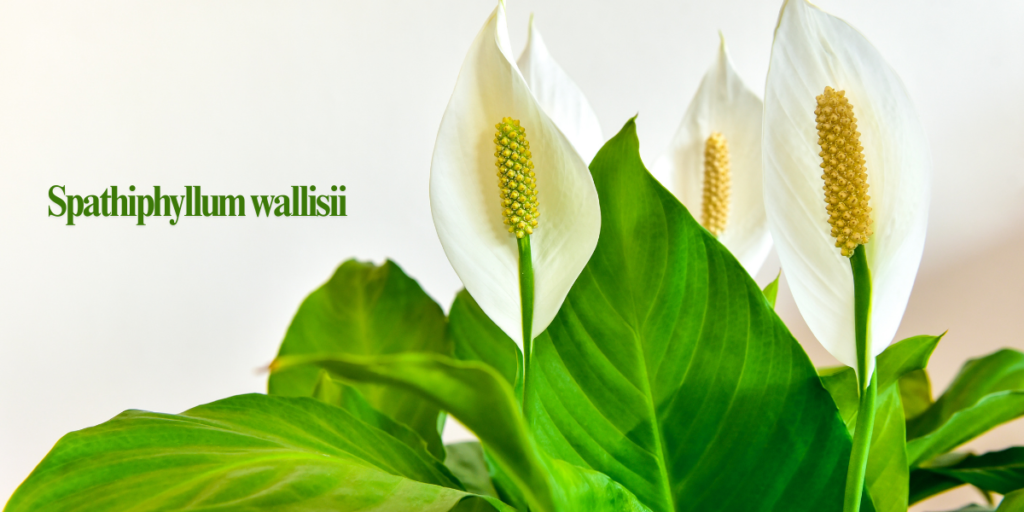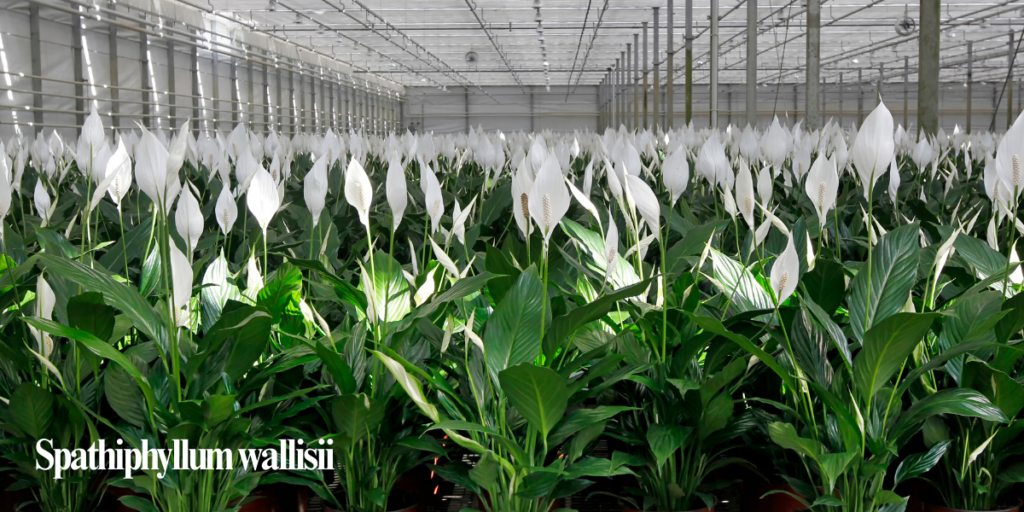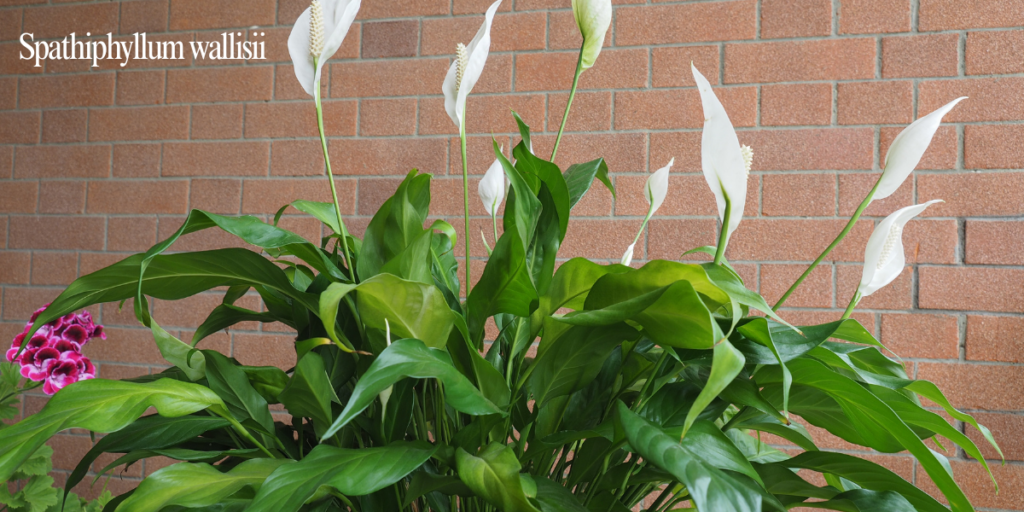Spathiphyllum wallisii (Peace Lily): Care, Benefits, and Growth Tips
Spathiphyllum wallisii, commonly known as the Peace Lily, is a beloved houseplant revered not only for its stunning aesthetic appeal but also for its numerous health benefits. With lush green leaves and distinctive white blooms, this plant has become a favorite among indoor gardeners and decorators alike. Originating from the tropical rainforests of Central and South America, the Peace Lily has adapted well to indoor living, thriving in low-light conditions and adding a touch of elegance to any space. More than just a beautiful decoration, it serves as a natural air purifier, making it an excellent choice for enhancing indoor air quality.
Overview and Key Features

Spathiphyllum wallisii belongs to the Araceae family, which includes many well-known houseplants. Its key features contribute to its popularity and appeal among plant enthusiasts.
Key Features:
- Leaf Structure:
- The leaves of Spathiphyllum wallisii are large, glossy, and dark green, measuring up to 12 inches in length and 4 inches in width. Each leaf is oval-shaped with a prominent central rib, giving it a structured appearance. The surface of the leaves is smooth and shiny, reflecting light and creating a vibrant look. This lush foliage not only enhances the visual interest of any room but also plays a role in the plant’s air-purifying abilities, as the large surface area helps to filter toxins from the air.
- Flowers:
- One of the most striking features of the Peace Lily is its flowers, which consist of a white spathe surrounding a central yellow spadix. The spathe is a modified leaf that serves to attract pollinators, and while the Peace Lily is not primarily grown for its flowers, the blooms add a touch of elegance and can last for several weeks. The flowers typically emerge in the spring and can continue to bloom intermittently throughout the year, providing a delightful display of white against the rich green foliage. When the flowers fade, they can be removed to encourage further blooming.
- Size:
- The Peace Lily generally reaches heights of 1-4 feet, depending on the variety and growing conditions. This size makes it versatile for various indoor placements, from tabletop displays to floor arrangements. Its stature allows it to fill empty spaces in a room effectively, making it a popular choice for both home and office environments.
Natural Habitat and Origins
Understanding the natural habitat of Spathiphyllum wallisii provides insight into its care requirements and growth patterns.
Adaptations:
- Tropical Rainforest Origins:
- Native to the understory of tropical rainforests in Central and South America, the Peace Lily thrives in a warm, humid environment. The canopy of the rainforest provides dappled sunlight, which means that the Peace Lily is adapted to low-light conditions and can grow without direct sun exposure.
- Moisture-Retaining Adaptations:
- In its native habitat, the Peace Lily absorbs moisture from the humid air, which is essential for its growth. This characteristic means that the plant can tolerate brief periods of drought, but it prefers consistent moisture to maintain its lush appearance.
Ideal Growing Conditions
To cultivate a healthy and thriving Spathiphyllum wallisii, it’s essential to provide growing conditions that align with its natural habitat.
Light Requirements:
- Indirect Light:
- The Peace Lily flourishes best in bright, indirect sunlight. Direct sunlight can scorch the leaves, causing them to develop brown patches or curl. Ideally, it should be placed near a north or east-facing window, where it can receive filtered light. In lower light conditions, the plant can still survive, but its growth may slow, and flowering may be reduced.
- Light Sensitivity:
- If the plant is stretching or leaning toward the light source, it may need to be repositioned to receive more balanced light. A general rule is that if the plant is consistently producing fewer flowers or exhibits slow growth, it might benefit from brighter light.
Watering:
- Consistent Moisture:
- Maintaining the right moisture level is crucial for the health of Spathiphyllum wallisii. The soil should remain consistently moist, but not waterlogged. Overwatering is one of the most common issues and can lead to root rot, while underwatering can cause wilting and leaf drop. Typically, watering every 1-2 weeks is sufficient, but the frequency may vary based on humidity, temperature, and pot size.
- Water Quality:
- Using room-temperature distilled or filtered water is recommended, as Peace Lilies can be sensitive to the chemicals present in tap water, like chlorine and fluoride. These chemicals can lead to leaf browning or drooping, so ensuring good water quality can prevent such issues.
Temperature and Humidity:
- Temperature Range:
- Spathiphyllum wallisii thrives in temperatures ranging from 65°F to 85°F (18°C to 29°C). It can tolerate a range of temperatures, but exposure to drafts, sudden temperature changes, or frost can be detrimental. Keeping the plant away from heating and cooling vents can help maintain a stable environment.
- High Humidity:
- This plant thrives in high humidity, which mimics its natural rainforest habitat. Ideally, humidity levels should be maintained above 50%. If the air is excessively dry, the leaves may start to show brown tips or edges. To increase humidity, you can mist the leaves regularly, place a humidity tray filled with water and pebbles beneath the pot, or use a humidifier to create a comfortable environment.

Common Issues and Solutions of Spathiphyllum wallisii
While Spathiphyllum wallisii is generally low-maintenance, it can encounter a few common challenges. Understanding these issues and their solutions can help keep your plant healthy.
Yellowing Leaves:
- Causes:
- Yellowing leaves are often a sign of overwatering, which can lead to root rot, but they may also indicate nutrient deficiencies or underwatering. If the leaves turn yellow and become mushy, this is a clear sign of overwatering.
- Solution:
- To address yellowing leaves, check the soil moisture levels. If the soil is too wet, reduce watering frequency and ensure the pot has adequate drainage holes. If the plant is underwatered, increase watering gradually. Additionally, consider fertilizing with a balanced houseplant fertilizer during the growing season to replenish nutrients, especially if you haven’t fertilized in a while.
Wilting:
- Causes:
- Wilting leaves can result from underwatering or low humidity levels. The Peace Lily is particularly sensitive to dry conditions, which can cause the leaves to droop.
- Solution:
- If you notice wilting, ensure the soil is adequately moist. Increase watering frequency if necessary, and consider raising the humidity level around the plant. If the leaves remain wilted after watering, inspect the roots for signs of rot; healthy roots should be white or light tan and firm, while rotting roots will appear brown and mushy.
Pest Infestations:
- Common Pests:
- Peace Lilies can attract pests such as spider mites, mealybugs, and aphids, particularly in dry indoor environments. These pests can cause damage by feeding on the plant’s sap, leading to stress and diminished health.
- Solution:
- Regularly inspect your plant for signs of pests. If an infestation is detected, treat it promptly with insecticidal soap or neem oil, ensuring to cover all surfaces of the leaves and stems. Increasing humidity can also deter pests, as they thrive in dry conditions.
Propagation Methods for Spathiphyllum wallisii

Spathiphyllum wallisii can be propagated easily, allowing gardeners to expand their collection or share plants with friends. The most common method is division.
Division:
- Remove the Plant:
- Begin by carefully taking the Peace Lily out of its pot. Gently shake off excess soil to inspect the root system, being cautious not to damage the roots during the process.
- Identify Sections:
- Look for natural divisions or clusters in the root system that can be separated. Each section should have a few roots and leaves to ensure successful propagation.
- Separate and Re-Pot:
- Gently separate the sections using clean, sharp scissors if necessary. Re-pot each division into individual containers filled with fresh, well-draining potting mix, ensuring the roots are spread out comfortably.
- Care After Propagation:
- After re-potting, water the newly potted divisions thoroughly and place them in a warm, bright spot with indirect light. Avoid direct sunlight until they establish roots and start to grow.
Uses of Spathiphyllum wallisii
Spathiphyllum wallisii is valued for its beauty and numerous benefits, making it a versatile addition to any indoor space.
Air Purification:
- Indoor Air Quality:
- Peace Lilies are recognized for their air-purifying capabilities, having been included in studies by NASA that highlighted their ability to filter harmful indoor pollutants such as formaldehyde, benzene, and ammonia. By removing these toxins from the air, Peace Lilies contribute to a healthier indoor environment, making them especially beneficial for homes and offices where air quality is a concern.
Decorative Uses:
- Aesthetic Appeal:
- The Peace Lily’s lush foliage and striking white blooms make it an elegant decorative piece suitable for various interior styles. Its sophisticated appearance enhances the ambiance of living rooms, offices, and even bedrooms, adding a touch of nature to indoor spaces.
Therapeutic Benefits:
- Mental Well-Being:
- Interacting with houseplants like Spathiphyllum wallisii has been shown to reduce stress and promote a sense of well-being. The presence of greenery indoors can enhance mood, improve focus, and create a calming atmosphere, making it an excellent choice for both homes and workplaces.
FAQs about Spathiphyllum wallisii
- How often should I water my Spathiphyllum wallisii?
- Water the Peace Lily when the top inch of soil feels dry, usually every 1-2 weeks. Adjust frequency based on environmental conditions like humidity and temperature.
- Can I propagate my Spathiphyllum wallisii?
- Yes, the Peace Lily can be easily propagated through division. This method allows you to create new plants to keep or share with friends.
- What are the best light conditions for Spathiphyllum wallisii?
- Peace Lilies thrive in bright, indirect light but can tolerate low-light conditions. Refrain from putting them in direct sunlight to avoid scorching the leaves.
- Is Spathiphyllum wallisii toxic to pets?
- Yes, Peace Lilies are mildly toxic to pets if ingested. Symptoms may include drooling, vomiting, or difficulty swallowing. Keep this plant away from pets to ensure their safety.
- Why are the leaves turning brown?
- Browning leaves can indicate either overwatering or underwatering, as well as exposure to low humidity. Assess your watering routine and humidity levels to identify the cause.
Conclusion
Spathiphyllum wallisii, or the Peace Lily, is a captivating and beneficial houseplant that enhances the beauty and air quality of any indoor environment. With its low-maintenance requirements and resilience, it is an ideal choice for both novice and experienced gardeners. By understanding the specific needs of this plant and how to provide proper care, you can enjoy the elegance and tranquility it brings to your home for years to come. The Peace Lily’s ability to adapt to various lighting conditions and its remarkable air-purifying qualities truly make it a valuable addition to any indoor garden.








Post Comment